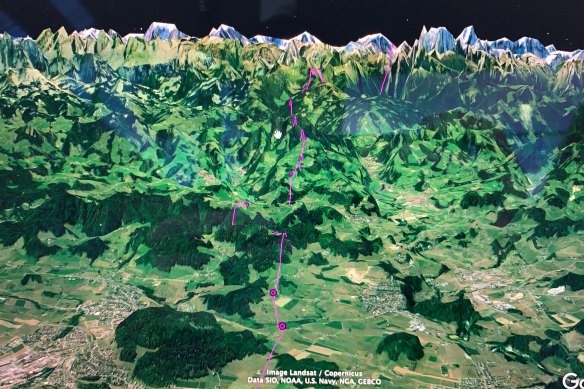
In the 19th century the moth was denounced by an entomologist as a “device of evil spirits” that foretold war, disease, hunger and death. The genus hawkmoths fall under, Acherontia, is drawn from the “river of pain”, Acheron, in Greek mythology.
In modern times the moths haunted the cover art for 90s thriller flick The Silence of the Lambs. And they’re the boogeyman to the bees; the hawkmoths feed by creeping into bee hives and feasting on honey. (Some entomologists hypothesise the skull marking resembles a worker bee, and the moths emit an odour that disguises their presence in the hive.)

The flightpath of a death’s head hawkmoth towards the foothills of the Swiss Alps. Credit:Max Planck Institute of Animal Behaviour
They also emit an audible “scream” when prodded.
But Myles revealed another eerie aspect to the moths: even on gusty nights, they travel long distances in a dead-straight line.
“It is really quite incredible. They can hold these very straight tracks and actually maintain them over quite long distances. People [thought] insect migration was really very much just driven by winds.”
Loading
Myles said the navigation tactics of the moths were akin to birds. On a strong tailwind, the moths flew higher and slower, allowing the winds to propel them forward. On gusty nights they hugged the ground and fought back on crosswinds, maintaining a decisive direction from Germany across the lowlands, and then into the foothills of the Alps.
Myles tracked one moth that travelled an epic 80 kilometres over four hours. He said the moths must be navigating using external cues and an internal compass.
“We’ve seen from Bogong moths in Australia that they can detect the Earth’s magnetic field and can navigate by that field,” said Myles of their navigation, adding that to travel accurately they were probably using visual landmarks like mountaintops to aid their flight.
Now back in Australia, Myles is keen to track species of butterfly and hoverfly, and discern the movements of our own species of migratory hawkmoths.
Get to the heart of what’s happening with climate change and the environment. Our fortnightly Environment newsletter brings you the news, the issues and the solutions. Sign up here.









 Add Category
Add Category